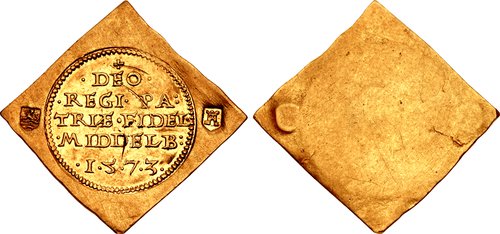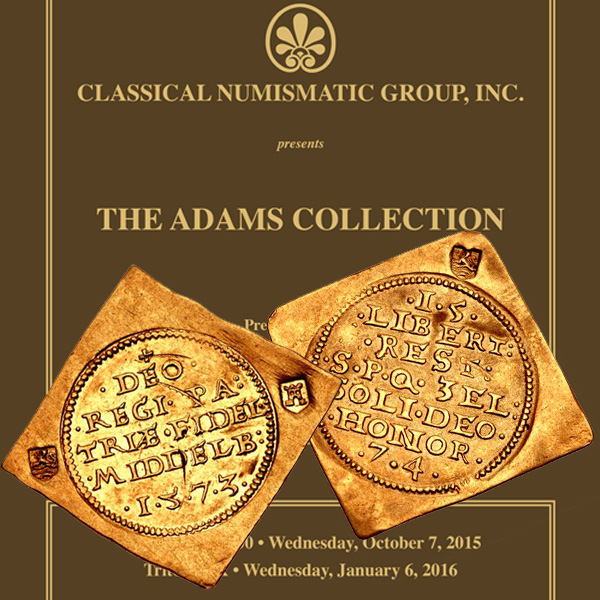The Adams Collection – Middelburg 1573 and 1574 ducat klippes
Middelburg ducat klippes, are in fact not ducats, but crowns. They were minted in various weights: single (3.5 gm), double (7.0 gm), quadruple (14 gm), and probably a triple (10.5 gm) as well. The coins sold in the recent CNG auction are single klippe “ducatsâ€, but they differ significantly. The first one (with the date of 1573) was minted on January 20, 1574/3, with most intended to be offered as commemorative medals. The second coin was minted in March 1574/3, after the surrender, probably to meet payments to the victors. They are usually smaller and thinner than those minted in January. Aforementioned dual dates are a result of the calendar reform and the changing of the occurrence of New Year’s Day in these territories in 1573. Aforementioned dual dates are a result of the calendar reform and the changing of the occurrence of New Year’s Day in these territories in 1573.
Middelburg klippes are siege coins, but in fact Middelburg was not exposed to ordinary attack, nor was it truly under siege. The whole island where the city was located was blockaded during the years 1572 and 1573, by the Geuzen (privateers) vessels. It’s worth mentioning that these privateers, so-called Geuzen, were known for their courage and fighting against much a bigger fleet. Thus Geuzen easily blocked the Spanish army in the city. What’s more, all deliveries of supplies – food as well as weaponry – coming by sea were destroyed or forced to retreat.
It’s not surprising that in this situation food supplies in the city shrank quickly. By late 1572 the situation of defenders in Middelburg was critical. Due to a very cold winter of 1572/73 a number of people died. In February 1573 the last attempt of the Spanish fleet to provide food supplies for the army staying in the city failed: a huge Spanish fleet of 83 ships was defeated by Geuzen. Soon afterwards, Mondragon the commander of the Spanish garrison, surrendered.
The situation in the city was reflected on the Middelburg gold siege coins. Middelburg suffered because of hunger. It is mentioned in the city chronicles as well as in the inscriptions on the reverse sides of several siege coins (quadruple and double pieces). One such Dutch inscriptions says: “Toen ik werd geslagen, Middelburg werd belegerd. Zo van dat het volk aten van de honger paarden, honden, huinen door de noodzaak, katten, ratten, en de lijnzaad wafels in plaats van brood†(“When I was striking this coin, Middelburg was besieged. The people, pressed by hunger, ate horses, dogs, leather in need, cats, rats and linseed waffles instead of bread.â€).



(source: cngcoins.com)



